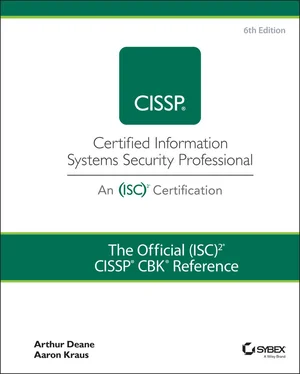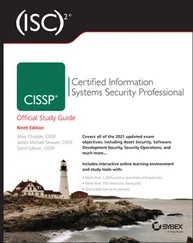Once a potential employee or contractor is identified, your organization should verify the information in their application and confirm their suitability for the position by conducting a background check. Generally speaking, an employment background check may include the following checks and verifications:
Education
Work history
Citizenship
Criminal record
Credit and financial history
References
In addition to the previous list, candidate screening may include drug testing and/or further investigation for highly sensitive roles, or positions requiring a special security clearance (this is especially relevant for employment with a government agency). As a CISSP, you should ensure that your organization has policies and procedures in place to screen and hire candidates in accordance with any relevant regulations in your jurisdiction.
NOTEWhile background investigations used to be strictly handled by organizations specifically created to conduct them, many employers have added online background screening to their standard procedures. In these circumstances, an employer may choose to research a potential candidate's social media and online presence to gain a fuller picture of that person's attitude, intelligence, professionalism, and general character. Organizations should have clear policies that define the appropriate uses of internet and social media research, standardize which information is to be taken from the social media sites, verify the accuracy of the information, and disclose to applicants the potential use of internet and social media in deciding which applicants to consider.
Employment Agreements and Policies
When joining an organization, an employee generally signs an employment contract that may include one or more employee agreements that make certain stipulations by which the employee must abide. The most common employee agreements are nondisclosure agreements and noncompete agreements.
A nondisclosure agreement (NDA) is an agreement that restricts an employee or contractor (or anyone else with access to sensitive information) from disclosing sensitive information they obtain through the course of their employment or relationship with an organization. An NDA is designed to protect the confidentiality of the organization's data (such as trade secrets or customer information) and is often a lifetime agreement (even after the employee leaves the company).
A noncompete agreement is an agreement that restricts an employee from directly competing with the organization during their employment and, in most cases, for a fixed time after employment. Noncompetes are one-way agreements that are designed to protect organizations from unfair competition by former employees or contractors. As an example, if you are hired as a hardware engineer for a mobile phone designer, you may be required to sign a noncompete stating that you will not work for other companies that design mobile phones for at least 18 months after termination of your employment; the idea here is that your inside knowledge of the company will present less of a disadvantage after those 18 months.
In addition to NDAs and noncompete agreements, employees may be responsible for reviewing and/or signing various employment policies such as acceptable use policies, code of conduct, or conflict of interest policies.
Onboarding, Transfers, and Termination Processes
Onboarding, transfers, and termination are three stages of employment that each comes with its own security considerations. The processes that bring people into an organization set the tone for their work behavior. Similarly, employee termination processes should clarify people's obligation to respect the protection of the organization's intellectual property and data security as they leave the company. As a security professional, you should be actively engaged with the business to ensure that onboarding, transfer, and termination processes are clearly documented and set behavior expectations during all stages of employment.
Setting good expectations for work behavior should start before the employee walks in the door. Part of the employee orientation program should address information security expectations and requirements. Employees should be reminded of their obligations to protect information and current threats to the organization's information assets, particularly if they are likely to be the targets of malicious actors. Further, orientation practices should inform new employees of the processes for reporting security incidents, their role in maintaining the security of their work area, and the company's classification and categorization processes so they can identify the level of control necessary for particular information.
Employees should also be made generally aware of the existence of controls that monitor their use of the organization's assets. Not only does this provide them with assurance that the organization does indeed take action to protect its information, but the information alone may act as a deterrent to inappropriate behavior. The intent is not to provide the employee with sufficient technical detail to defeat the controls, but to make sure they understand that their actions may be scrutinized.
Organizations should have well-defined policies and procedures for handling an employee transferring from one role to another. Part of this process should involve reviewing the employee's existing access to information and evaluating the need for continued access to the same information. Where possible, your organization should seek to remove access that will no longer be needed in the employee's new role; this enforces the principle least privilege, which we discussed earlier in this chapter. In addition, you should have a process in place to identify any role-based training that the employee needs to take prior to the transfer; this is particularly critical when the employee's new role comes with new responsibilities or access to information at a higher sensitivity.
Taking appropriate care when people depart an organization is just as important as ensuring they are properly brought into the organization. Terminations may be voluntary (i.e., an employee retires or finds a new job) or involuntary (i.e., an employee is fired, furloughed, or otherwise “let go”). These former insiders represent a risk to the organization, and appropriate actions must be taken to ensure they do not compromise the operations, intellectual property, or sensitive information with which they have been entrusted.
When an individual leaves an organization on good terms, it is relatively easy to go through the standard checklist: suspending electronic access, recovering their access badges and equipment, accounting for their keys, and changing the key codes on cipher locks that the departing employee used are among many other standard practices. Most organizations have well-structured off-boarding processes to ensure the removal of access when an individual is no longer entitled to organizational information or resources.
Involuntary termination of employment is an emotionally charged event for all involved. In virtually all cases, an involuntary termination forces the employer to assume the terminated individual is a threat to the organization, and appropriate action should be taken to protect organizational assets. Termination procedures at most organizations include specific processes to notify the information security organization to disable access to electronic and physical systems.
Where possible, recovery of property that an involuntarily terminated employee used should be attempted. Where appropriate, the recovered material should be tracked as evidence and retained for subsequent forensic analysis. Finally, once the individual has left the organization, remaining staff should be informed that the terminated individual is no longer allowed access and that any attempts by that individual to access resources or property should be reported.
Читать дальше












